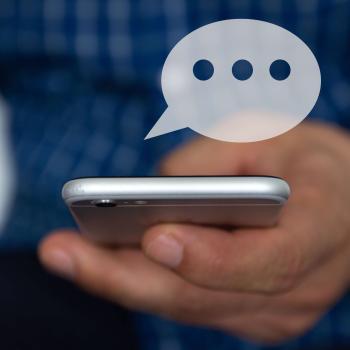If a Body Texts a Body: Texting in The Catcher in the Rye

- Preview |
- Standards |
- Resources & Preparation |
- Instructional Plan |
- Related Resources |
- Comments
Overview
Students imagine the possibilities afforded by text messaging technology in The Catcher in the Rye in this lesson that serves as a review of the novel, an exploration of Holden Caulfield's character and narrative voice, and a study of a now everyday form of communication. Students first compare and contrast several forms of communication: telephone, text message, and letter or email. They then select five moments in the novel in which Holden may have sent a text message had the technology been available. The lesson concludes with students sharing their text messages and a discussion of the rationales behind their choices.
Featured Resources
- Brainstorming Handout: Texting in the Rye: Students use this printout to think critically about how texting may have changed the novel.
- Possible Selections for Text Message Communication: This printout points out possible parts of the novel for which students may want to consider writing text messages.
- Text Messages Planning Chart: This printout is used to plan the text messages that students will write for the novel.
From Theory to Practice
In the NCTE Council Chronicle article "The Shift to 21st-Century Literacies," Sara Kajder notes that as information technologies continue to evolve, teachers "'have opened up what counts as valued communication' in the classroom" (4). One way that teachers can acknowledge the continued rapid shift to more technology-driven communication is to allow students to use communication forms that they already value to achieve literacy goals traditionally associated with the English language arts classroom, such as relating to characters and responding to text.
William Kist points to the specific transition from "a page-based to a screen-based society," contending that "'[i]t's a different way of encountering communication or thought or human expression'" (5). Inviting students to respond to literature in the format of a series of text messages achieves two goals: It shows that teachers value forms of communication in which students already engage, and it allows teachers to discuss with students ways in which new means of communication are similar to and different from more traditional ways expressing meaning.
Further Reading
Common Core Standards
This resource has been aligned to the Common Core State Standards for states in which they have been adopted. If a state does not appear in the drop-down, CCSS alignments are forthcoming.
State Standards
This lesson has been aligned to standards in the following states. If a state does not appear in the drop-down, standard alignments are not currently available for that state.
NCTE/IRA National Standards for the English Language Arts
- 1. Students read a wide range of print and nonprint texts to build an understanding of texts, of themselves, and of the cultures of the United States and the world; to acquire new information; to respond to the needs and demands of society and the workplace; and for personal fulfillment. Among these texts are fiction and nonfiction, classic and contemporary works.
- 2. Students read a wide range of literature from many periods in many genres to build an understanding of the many dimensions (e.g., philosophical, ethical, aesthetic) of human experience.
- 3. Students apply a wide range of strategies to comprehend, interpret, evaluate, and appreciate texts. They draw on their prior experience, their interactions with other readers and writers, their knowledge of word meaning and of other texts, their word identification strategies, and their understanding of textual features (e.g., sound-letter correspondence, sentence structure, context, graphics).
- 4. Students adjust their use of spoken, written, and visual language (e.g., conventions, style, vocabulary) to communicate effectively with a variety of audiences and for different purposes.
- 5. Students employ a wide range of strategies as they write and use different writing process elements appropriately to communicate with different audiences for a variety of purposes.
- 6. Students apply knowledge of language structure, language conventions (e.g., spelling and punctuation), media techniques, figurative language, and genre to create, critique, and discuss print and nonprint texts.
- 9. Students develop an understanding of and respect for diversity in language use, patterns, and dialects across cultures, ethnic groups, geographic regions, and social roles.
Materials and Technology
- Copies of The Catcher in the Rye by J. D. Salinger
Printouts
Websites
In this Washington Post column, a book critic reconsiders the merit of The Catcher in the Rye over fifty years after its publication.
This brief article poses the possibility of other works of fiction that might be considered as more modern alternatives to the classic coming-of-age novel.
Preparation
- Make copies of necessary handouts.
- Arrange for students to have access to Internet-connected computers during Session One.
- Test and bookmark the Three-Circle Venn Diagram Tool. Ensure that you have the latest version of Flash on student computers. This plug-in can be downloaded through the Technical Support page.
- Think through the activity involving the Three-Circle Venn Diagram Tool in preparation for the discussion in Session One.
Student Objectives
Students will:
- consider ways in which three major forms of personal communication are similar and different.
- choose appropriate situations in the novel to represent Holden sending a text message.
- determine audience, purpose, voice, and rationale for text messages written in selected situations.
- compare and contrast representations selected by classmates.
Session One
- After finishing the novel The Catcher in the Rye, direct student groups to the Three-Circle Venn Diagram Tool.
- Give students time to brainstorm and complete the activity prompted by the interactive. They will be comparing and contrasting communication through telephone, text messages, and letters or email by considering these questions:
- When do people use this mode of communication? In what situations and at what times of day is it appropriate to communicate this way?
- With whom do people use each of the forms of communication?
- How does this form of communication actually function?
- What are the advantages and disadvantages of each form of communication?
- As students work, circulate the room to answer questions and help groups that might need additional assistance or prompting.
- Ask students to print their work and facilitate a discussion of the ways these three modes of communicating are similar and different. Be sure students cover issues such as the informality and perceived non-intrusiveness of sending a text message, the expectation of a caller on a cell phone that the owner of the phone will answer (as opposed to a family member with traditional land lines), and the personal/more permanent nature of a letter.
- Close the session by sharing with students the first page of Chapter 9 of Catcher in the Rye, when Holden lists all the people he would like to talk to over the phone, but various circumstances prevent him from doing so.
- Ask students to think before the next session about ways the novel might have been different had Holden Caulfield had access to cell phone technology, specifically text messaging. Distribute the Brainstorming Handout and have them respond to the two questions before the next session.
Session Two
- Remind students of their work in the previous session, including the passage from the novel in which Holden's attempts to communicate are thwarted.
- Ask students to get out their completed Brainstorming Handouts and facilitate a brief discussion about their responses to the first question.
- From this discussion, challenge students to discern at least five points in the novel in which Holden would have communicated with someone via a text message had it been possible at the time. Remind students to use their thinking from the Three-Circle Venn Diagram Tool to facilitate this process.
- Have students get back into their groups from the previous session and give them time to generate their list of points.
- After groups have a list of particular points in the novel, have them share these in a brief discussion as you record them on the board or overhead projector. The goal at this point is to give the class the widest range of possibilities, not necessarily to select the ones that have the most merit. (See the Possible Selections for Text Message Communication for a starter list).
- Distribute the Text Messages Planning Chart and discuss with students the elements of the chart. In addition to deciding on the five situations they will represent, they should consider the audience for the message (the intended recipient), the message Holden will send, and the reason why they chose this moment to communicate through a text message.
- As the groups are working through the Planning Chart, they should refer to their responses to the second question on the Brainstorming Handout, incorporating their thinking about voice into the messages Holden writes. You may wish to use activities or resources from the ReadWriteThink lesson Style: Defining and Exploring an Author's Stylistic Choices to facilitate this process.
- Have students complete as much of the Planning Chart together as class time allows. Students should finish the chart for the next session.
Session Three
- Have students get out their completed Planning Charts.
- Direct students to get back into their groups, where they will have time to select the best ideas and representations, as well as make any necessary changes based on the group's feedback.
- When students are finished, facilitate an organized sharing of their work.
- Have students take out their copies of the novel, and ask groups to share their invented text messages chronologically. If multiple groups chose to represent the same moment in a text message, have all the groups share before moving on to the next point in the novel.
- After each round, facilitate a discussion about the similarities and differences in the texts that represent the same moment in the novel, as well as the similarities and different in the moments the different groups chose to represent.
Extensions
- Ask students to select one of the text messages that, if Holden had been able to send it, may have changed the course of the novel. Have them write a brief creative piece that plays out the consequences of that communication and replicates his voice and persona.
- Holden leaves his sister Phoebe a handwritten note toward the end of the novel. Depending on whether any group chose to re-cast that communication as a text message, engage students in a debate about what is lost and/or gained by changing that particular scene.
- Though this lesson focuses on text messaging, students can be invited to explore other forms of instant communication (with different audiences and purposes), such as social networking status updates and tweets, throughout the novel.
Student Assessment / Reflections
- Provide feedback to groups as they complete the Planning Chart, paying special attention to the quality of their responses in the rationale column.
- Observe student participation in the conversation during the sharing process. Encourage students to think critically about their choices (and those of their classmates) and about the very activity of re-casting communication in the novel.
- After all groups have shared, have students complete these Reflection Questions.

THANX!
THANX!
THANX!
Add new comment